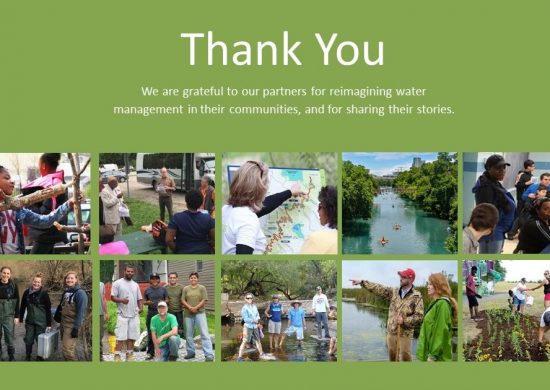We know that clean water is essential for the health of humans, plants, animals and our economy. Helping to move towards the goal of having safe, sufficient, secure water resources for our nation, Pisces Foundation has embarked on a path to partner with others to “employ technology to empower the engaged public to better protect water resources, in both urban and agricultural areas.”
While there are many facets to this body of work, I am pleased to report the latest on two of these efforts.
As noted in my blogs in November 2015 and February 2016, the Pisces Foundation has joined forces with the Intel Corporation to conduct a national survey of watershed organizations, schools and citizen volunteers to determine how they use monitoring equipment and information technologies to collect and disseminate water quality information and their interest and awareness of emerging technologies that could bring down the cost or improve the quality of the information that they collect and use to monitor and protect water quality.
With deep appreciation to those who helped distribute and respond to the survey, and to the project’s Steering Committee and staff, we report that 84% of respondents believe “widespread availability of low-cost equipment could affect major improvements in water quality.”
Attached are links to the survey results (Summary and more detailed draft), but some of the take home points are:
- The top 4 needs for low-cost monitoring equipment are to: target problem areas; use as a screening tool for advanced/expert level monitoring/investigation; report pollution incidents; use as part of monitoring and verification protocols for watershed protection and restoration projects, etc.
- The top 5 desired parameters to monitor using low-cost equipment: nutrients (forms of nitrogen and phosphorus and associated chlorophyll A concentrations; bacteria (fecal coliform, E.coli, etc.); dissolved oxygen; electrical conductivity and turbidity. Quite a few survey respondents also monitor for macroinvertebrates to measure the health of the biological community in water bodies.
- Survey respondents were particularly interested in monitoring equipment that costs less than $100 per monitoring device.
- Most survey respondents currently use manual methods for gathering data (i.e., field kits or grab samples with lab analysis) but many would prefer to use automatic or semi-automatic means of data collection.
- The top 4 desired features of low cost monitoring equipment are durability, in field data entry, remote sensing and data loggers, and metadata capture.
In addition to the needs of watershed organizations and others for low-cost equipment to collect water quality information, 78 % of survey respondents report that they currently lack knowledge of low-cost data access and sharing technologies that they could use to make better use of the monitoring data that they collect.
As stated in my May 2016 blog announcing the release of the survey, based on analysis of the survey results, a second phase of the project will focus on finding ways to stimulate improvements in technology development and deployment. At this point, we are discussing next steps with our Steering Committee. Among the items under consideration are actions to:
- Identify available low-cost nutrient monitoring technologies identified as priorities from the survey, their capabilities, and cost
- Identify ways to help non-governmental water quality monitoring efforts to obtain access to enhanced low-cost water quality monitoring equipment
- Share best practices and promote the use of peer supported tools for collecting and sharing water quality information
- Demonstrate how improved technology to collect and share information can empower citizen organizations to protect and restore their rivers, lakes and streams.
- Promote improvements in technology and explore market incentives through collaborative efforts with nonprofits, academics, governmental entities, technology providers, and other philanthropies to ensure that the market is meeting the needs of engaged members of the public for monitoring and data sharing equipment.
We hosted a webinar in January 2017 to review the results of the survey and to provide information on next steps to address findings. You can view a recording of the webinar here.
This was also advertised on a suite of helpful citizen science list serves you may want to check out. (Citizen Science Central at Cornell, EPA’s National Volunteer Monitoring Listserv, and the National Extension for Volunteer Water Monitoring at UVM)
We are very excited about how we might link the findings of the low-cost monitoring survey with other work we are sponsoring focused on the use of remote sensing to address water pollution, which I described in my September 2016 blog. On September 14-16, 2016 a group of experts from academia, federal and state agencies, nongovernmental organizations (NGOs), private companies, and foundation representatives, convened at the Wingspread conference center in Racine, Wisconsin for, “Using Remote Sensing to Empower the Public to Address Water Pollution.” The workshop generated many ideas about how researchers, technology companies, government agencies, NGOs and funders can collaborate to rapidly advance the use of remote sensing to address pollution in U.S. inland surface waters. The group focused on water pollution problems that can be tracked using publicly available remote sensing data from satellites including chlorophyll-A to detect algal blooms, turbidity, temperature and associated land-based pollution sources and sinks.
Several participating organizations demonstrated how they are currently using remote sensing data for water resource protection purposes, which sparked wide-ranging discussions for the balance of the meeting about how such approaches could become more widely available to entities working to protect water resources. Discussions revolved around the challenges and opportunities associated with obtaining or collecting remote sensing data, how it can be used to complement in situ data collection, and how it can be processed and packaged to make it available to and useful for target users.
While there are a number of challenges, it is clear that remote sensing is emerging as a powerful tool that, when used in combination with other monitoring tools and data, holds the potential to transform how NGOs and the public “gather intelligence” about water quality. You can find a complete summary of the workshop findings here. We continue to work with Meridian Institute on workshop follow-up activities, looking for ripe opportunities to pursue.
Here at Pisces, we are very interested in how we can help catalyze and create mechanisms that use remote sensing and in situ monitoring technologies and data. We envision NGOs making use of a suite of tools that help them create a robust understanding of water quality in the watersheds where they work, and allow them to pursue conservation or restoration approaches in a science-based, data-driven manner. With these latest projects, we see the threads of that vision coming into view and we look forward to working with many of you to keep moving forward.



